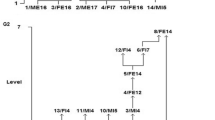Abstract
Under different criteria the individual members of groups of squirrel monkeys show different social capacities. The ranking of the subjects was much the same for Restraining and Genital display. The hierarchies for Approaching and Following fitted well with each other, showing few similarities with the above two. Location of individual ranks for Withdrawing tended to be the opposite to that of Approaching and Following.
Restraining and Genital display showed quasi-linear hierarchies, with males on top and females at the bottom of them. For Approaching, Following, Withdrawing, and Genital inspection the results varied from quasi-linear structure to circular or even unisexual arrangement. As a rule the animals behaved towards partners close in rank to themselves.
Several individual roles could be isolated: An alpha male role, directing Restraining and Genital display to all other partners more frequently than any of them towards him, basing his ability more in adequate distribution of total performance among social partners than in high total frequency; an omega male role under the same criteria, whose function would be to connect with the hierarchy of females and a scapegoat role, a very passive female receiving all kinds of attention from most subjects.
Similar content being viewed by others
References
Alvarez, F., 1973. Comportamiento social y hormonas sexuales enSaimiri sciureus.Monog. Cienc. Mod., 82: 1–74. C.S.I.C., Madrid.
Baldwin, J. D., 1968. A study of the social behavior of a semifree-ranging colony of squirrel monkeys (Saimiri sciureus).Folia. primat., 9: 281–314.
————, 1971. The social organization of a semifree-ranging troop of squirrel monkeys (Saimiri sciureus).Folia. primat., 14: 23–50.
Bronfenbrenner, U., 1945.The Measurement of Sociometric Status, Structure and Development.Sociometry Monographs, No. 6, Beacon House, New York.
Castell, R. v. &Heinrich, 1971. Rank order in a captive female squirrel monkey colony.Folia primat., 14: 182–189.
———— &D. Ploog, 1967. Zum Sozialverhalten der Totenkopf-Affen (Saimiri sciureus): Auseinandersetzukg zwischen zwei Kolonien.Z. f. Tierpsychol., 24: 625–641.
DuMond, F. V., 1968. The squirrel monkey in a seminatural environment. In:The Squirrel Monkey,L. A. Rosenblum &R. W. Cooper (eds.), Academic Press, New York & London, pp. 88–145.
Hall, K. R. L. &I. DeVore, 1965. Baboon social behavior. In:Primate Behavior,I. DeVore (ed.), Holt, Rinehart, & Winston, New York, pp. 53–110.
Maclean, P. D., 1964. Mirror display in the squirrel monkey,Saimiri sciureus.Science, 146: 950–952.
Mason, W. A. &G. Epple, 1969. Social organization in laboratory groups ofSaimiri andCallicebus. In:Proc. 2nd. Int. Congr. Primatol,C. R. Carpenter (ed.), S. Karger, Basel, pp. 59–65.
Mazur, A. &J. D. Baldwin, 1966. Huddle and sprawl behavior of semifree-ranging squirrel monkeys.Lab. Primate Newslet., 5: 5–8.
Ploog, D. W., 1967. The behavior of squirrel monkeys (Saimiri sciureus) as revealed by sociometry, bioacoustics, and brain stimulation. In:Social Communication among Primates,S. A. Altmann (ed.), The Univ. of Chicago Press, Chicago & London, pp. 149–184.
————,J. Blitz, &F. Ploog, 1963. Studies on social and sexual behavior of the squirrel monkey (Saimiri sciureus).Folia primat., 1: 29–66.
———— &P. D. Maclean, 1963. Display of penile erection in squirrel monkey (Saimiri sciureus).Anim. Behav., 11: 32–39.
Plotnik, R. J., F. A. King, &L. Roberts, 1965. An objective analysis of social dominance in the squirrel monkey.Proc. Amer. Psychol. Assn., 1: 109–110.
Thorington, R. W., 1967. Feeding and activity ofCebus andSaimiri in a Colombian forest. In:Progress in Primatology,D. Starck,R. Schneider, &H. J. Kuhn (eds.), Gustav Fischer Verlag, Stuttgart, pp. 180–184.
Winter, P. &D. W. Ploog, 1967. Social organization of squirrel monkeys in captivity. In:Progress in Primatology,D. Starck,R. Schneider, &H. J. Kuhn (eds.), Gustav Fischer Verlag, Stuttgart, pp. 263–271.
Author information
Authors and Affiliations
About this article
Cite this article
Alvarez, F. Social hierarchy under different criteria in groups of squirrel monkeys,Saimiri sciureus . Primates 16, 437–455 (1975). https://doi.org/10.1007/BF02382741
Received:
Accepted:
Issue Date:
DOI: https://doi.org/10.1007/BF02382741




